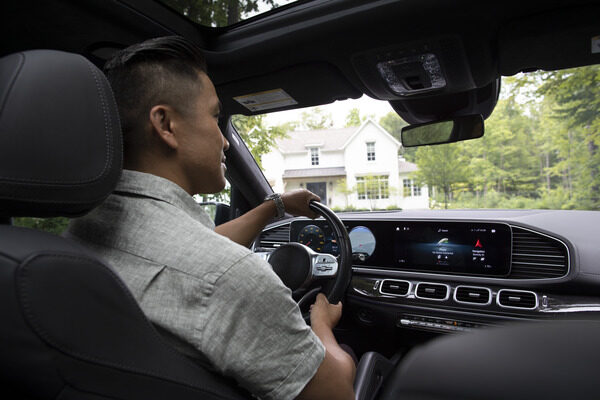Nearly half a million people are injured in distracted driving-related accidents each year. Learn about how to steer clear of the dangers of distracted driving.
What is distracted driving?
Distracted driving is a true hazard of the road. It’s the cause of countless accidents and is completely preventable. Activities ranging from eating to texting divert a driver’s attention from what’s most important – the road. You may be surprised by how just a few seconds of distracted driving can lead to a collision. Be aware of these diversions so you can avoid them and stay focused on safe driving.
Using a cellphone or other technology
According to the National Highway Traffic Safety Administration (NHTSA), 3,142 people were killed in distracted driving-related vehicle accidents.2 That means just over 9% of all fatal crashes in 2019 involved distracted driving.3
These statistics suggest it may be best to avoid cellphone usage when driving. It also may not be legal in your state to even hold your phone while driving. Utilize hands-free options for making calls. Better yet, pull over to talk; any phone usage can result in reduced concentration on driving.4 Taking your eyes off of the road to look up a contact or dial a number takes seconds, but you can travel a good distance in that timeframe.
Age is a factor, too
Using technology behind the wheel is a concern with younger drivers, who are involved in more accidents; the CDC reports that drivers ages 16–19 have a higher risk of vehicle accidents than any other age group.5 Adults and teens under the age of 20 are involved in more crashes related to distractions and more fatalities, too.6 Many phones offer settings that turn off notifications while in the car. Use of these features or apps may help cut down distracted and dangerous driving.
Consider these facts before using technology behind the wheel:
- 481,000 drivers use phones behind the wheel during the daytime7
- Texting for five seconds is like driving the length of a football field blindfolded if you’re going 55 miles per hour8
The NHTSA reports that it’s not possible to drive safely if the task doesn’t have your full attention. Paying attention to any potential distraction can increase your risk of an accident.9
Other distractions
Things many people do in the car every day are actually distractions that can put you at risk for accidents.10 While you might think of cellphones and texting as the main problems, other behaviors are similarly risky. Eating while driving not only distracts your mind from the road, but it may also cause you to drive with one hand or remove both hands from the wheel. Helping your kids with something in the backseat is a task every parent has probably done at least once, but it’s still a distraction.
Preventing distractions
Remember that driving is serious business. Vehicles weigh thousands of pounds. When operating at even modest speeds, the physics of a collision can be devastating. If you can’t stay off your phone, use an app or phone feature to turn off notifications. If you need to make a call or text, pull over. When using your maps, review the route before heading out to make sure you have familiarity and position your phone in an eye-level holder. Avoid eating in the car.
Practice Distracted Driving Awareness Month
April is distracted driving awareness month! You can use this month to help bring awareness to distracted driving by practicing safe driving habits, helping your driver operate the vehicle without distractions when you’re a passenger, and teaching your children good driving habits.
You and your family can also pledge to make the road a safer place by reviewing the Family Safe Driving Agreement. If you really want to go the extra mile, you can help spread the word about safe driving practices by displaying safe driving posters in your garage and the garages of friends and family and sharing infographics online.
Remember, many states now have laws against cellphone usage and texting and driving. Stay safe, and save yourself money by following these laws to avoid fines.
Staying safe on the road is easier when you create a plan and utilize driving safety tips. Learn more helping teens make good driving decisions.
1https://www.nhtsa.gov/risky-driving/distracted-driving
2https://www.nhtsa.gov/risky-driving/distracted-driving, Accessed August 2021.
3https://www.iihs.org/topics/fatality-statistics/detail/state-by-state, Accessed August 2021.
4http://www.nhtsa.gov.edgesuite-staging.net/Driving+Safety/Distracted+Driving/Policy+Statement+and+Compiled+FAQs+on+Distracted+Driving
5https://www.cdc.gov/transportationsafety/teen_drivers/teendrivers_factsheet.html, Risk Groups tab
6https://www.cdc.gov/transportationsafety/distracted_driving/
7https://www.nhtsa.gov/risky-driving/distracted-driving
8https://www.nhtsa.gov/risky-driving/distracted-driving
9https://www.nhtsa.gov/risky-driving/distracted-driving 10https://www.nhtsa.gov/sites/nhtsa.gov/files/documents/812_381_distracteddriving2015.pdf
Disclaimer:
The information included is designed for informational purposes only. It is not legal, tax, financial or any other sort of advice, nor is it a substitute for such advice. The information may not apply to your specific situation. We have tried to make sure the information is accurate, but it could be outdated or even inaccurate in parts. It is the reader’s responsibility to comply with any applicable local, state, or federal regulations. Nationwide Mutual Insurance Company, its affiliates and their employees make no warranties about the information nor guarantee of results, and they assume no liability in connection with the information provided. Nationwide, Nationwide is on your side, and the Nationwide N and Eagle are services marks of Nationwide Mutual Insurance Company. © 2021 Nationwide.



